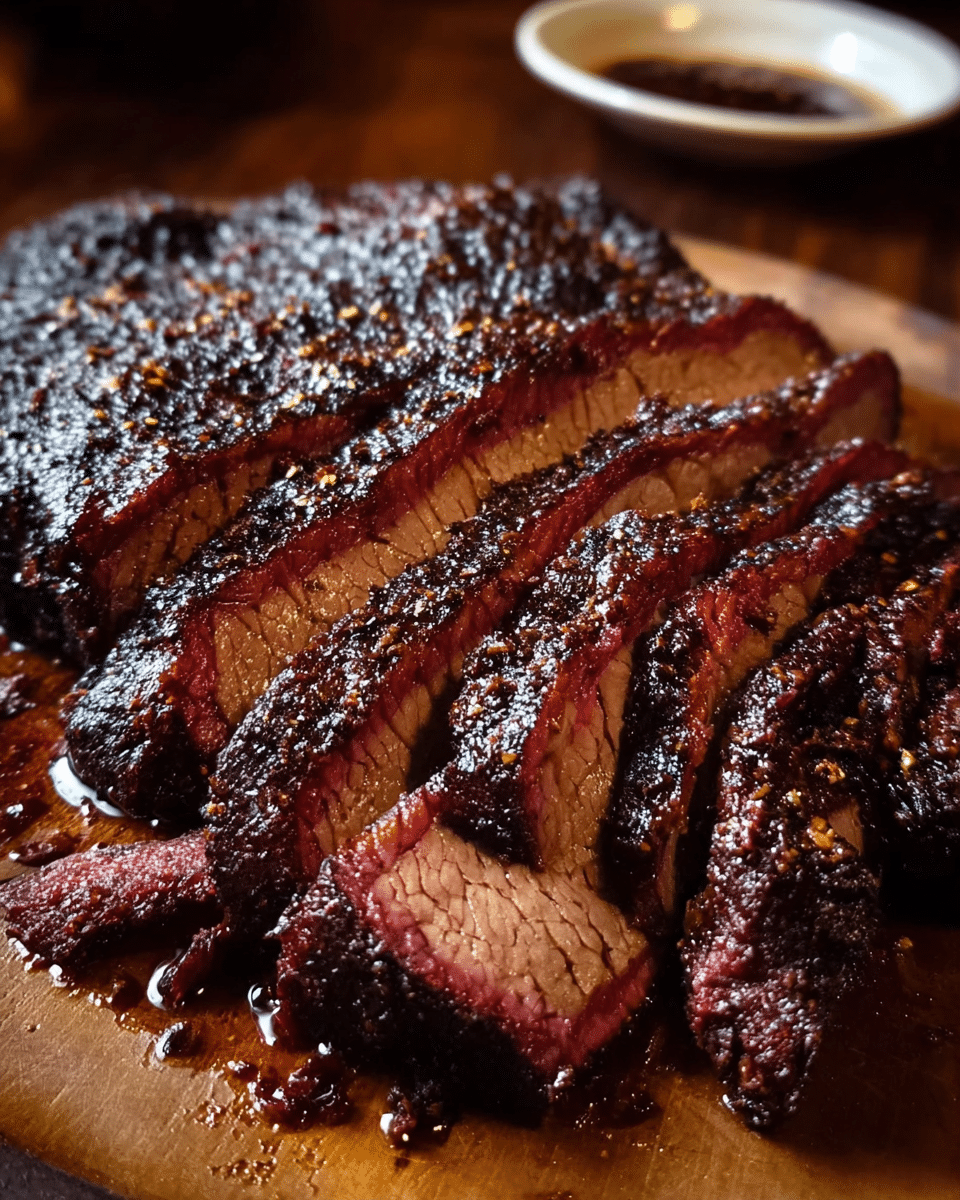Welcome to the world of Texas-style brisket, a barbecue favorite that has gained global popularity. This mouthwatering dish combines smoky flavors, juicy textures, and a rich deep smoke ring that forms around the meat. The key to perfecting Texas-style brisket lies in the slow-cooking process, which helps achieve tenderness and that distinctive smoky taste. Whether you’re a barbecue enthusiast or just love a good meal, this brisket will surely satisfy your cravings.
Full Recipe:
Ingredients
-
1 whole packer brisket (10-12 pounds)
-
Coarse salt
-
Coarsely ground black pepper
-
Garlic powder
-
Onion powder
-
Paprika
-
Cayenne pepper
-
Wood chips (preferably oak or hickory)
-
Barbecue sauce (optional)
Directions
-
Prepare the Smoker: Preheat the smoker to 225°F (107°C). Make sure the smoker is clean and in good working condition.
-
Trim the Brisket: Trim excess fat from the brisket, leaving about ¼ inch of fat on top. This will help keep the meat moist during cooking.
-
Make the Rub: In a small bowl, combine coarse salt, black pepper, garlic powder, onion powder, paprika, and cayenne pepper. This will be the seasoning rub for the brisket.
-
Season the Brisket: Generously coat the entire brisket with the rub, ensuring all sides are evenly covered.
-
Cook the Brisket: Place the brisket fat-side up in the smoker. Add wood chips (oak or hickory) to the smoker for a rich smoky flavor. Cook for about 1 hour per pound, or until the internal temperature reaches 203°F (95°C).
-
Rest the Brisket: Once the brisket is done, remove it from the smoker and let it rest for at least 30 minutes. This allows the juices to redistribute, ensuring a tender result.
-
Slice the Brisket: Slice the brisket against the grain into thin slices. This will help ensure each bite is tender.
-
Serve: Serve the Texas-style brisket with barbecue sauce on the side if desired.
Nutritional Value (per serving)
-
Calories: 450 kcal
-
Fat: 25g
-
Carbohydrates: 2g
-
Protein: 50g
-
Sodium: 800mg
-
Fiber: 1g
-
Sugar: 1g
This classic Texas-style brisket combines rich smoky flavors with tender, juicy meat. Perfect for any barbecue or gathering, it’s sure to impress your guests!
The Essence of Texas-Style Brisket
The secret to perfect Texas-style brisket lies in the slow-cooking method. Unlike quick, high-heat grilling, brisket requires patience and time. The meat is smoked at a low temperature for several hours, usually 1 hour per pound, allowing the connective tissues in the meat to break down and become incredibly tender. During this process, a thick, flavorful crust, known as the bark, forms on the outside of the meat, adding to its smoky complexity.
What sets Texas-style brisket apart from other barbecue styles is its simplicity in seasoning. The focus is on enhancing the natural flavors of the meat rather than masking them with complicated marinades or excessive sauces. A basic rub made of coarse salt, black pepper, garlic powder, and paprika provides the brisket with just the right amount of flavor, while still allowing the smoky taste from the wood chips to shine through.
The Brisket: Choosing the Right Cut
Texas-style brisket uses a whole packer brisket, which typically weighs between 10 and 12 pounds. A packer brisket consists of two parts: the flat, which is the leaner portion, and the point, which is fattier and more marbled. The balance between the two is what makes brisket such a satisfying cut of meat. When cooked properly, both sections are tender and juicy, with the point section offering a richer, melt-in-your-mouth experience due to its higher fat content.
The key to a perfect brisket is in the fat. The fat cap on top of the brisket acts as a protective layer during the smoking process, keeping the meat moist and infusing it with flavor. It’s important to leave about ¼ inch of fat on the brisket during the trimming process. Too much fat can lead to greasy meat, while too little can cause the brisket to dry out during the long cooking time.
The Smoking Process: Achieving the Perfect Bark
To achieve the signature smoky flavor of Texas-style brisket, it’s essential to use wood chips that will infuse the meat with deep, earthy flavors. Oak and hickory are the traditional choices for Texas barbecue, as they provide a robust smoke that complements the meat without overpowering it. The wood chips should be added to the smoker throughout the cooking process, ensuring a consistent level of smoke and heat.
Before placing the brisket in the smoker, preheat the smoker to 225°F (107°C). This low and slow approach is crucial to achieving the melt-in-your-mouth texture that Texas brisket is known for. Once the smoker is at the right temperature, the brisket is placed fat-side up on the grill. This allows the fat to render down into the meat, keeping it moist and flavorful throughout the cooking process.
The brisket will need to cook for approximately 1 hour per pound. For a 10-pound brisket, this means a cooking time of about 10 hours. During this time, the brisket will develop a beautiful smoke ring, a pinkish layer of meat near the surface, which is a hallmark of slow-smoked barbecue. It’s important to resist the temptation to check the brisket too often, as this can cause fluctuations in the smoker temperature. Instead, monitor the internal temperature of the meat. The brisket is ready when it reaches an internal temperature of 203°F (95°C).
Resting the Brisket: A Crucial Step
After the brisket has reached the desired internal temperature, remove it from the smoker and let it rest for at least 30 minutes. This step is essential as it allows the juices to redistribute throughout the meat, ensuring a moist and tender result. Resting also makes slicing the brisket much easier, as the fibers of the meat have had time to relax.
While resting, you may choose to wrap the brisket in foil or butcher paper to retain warmth. Some pitmasters prefer wrapping the brisket to prevent it from cooling down too quickly, while others leave it uncovered to let the bark remain crispy.
Slicing the Brisket: Against the Grain
When it’s time to slice the brisket, it’s important to cut against the grain. The grain refers to the direction of the muscle fibers, and cutting against it helps ensure each slice is tender. Use a sharp knife to slice the brisket into thin pieces, cutting both the flat and point sections for the best of both worlds. The flat will offer leaner slices, while the point will provide richer, juicier cuts.
Texas-style brisket is often served without barbecue sauce, as the seasoning rub and smoke flavors are meant to be the focus. However, if desired, a side of barbecue sauce can be served on the side for those who prefer a tangy or sweet complement to the rich, smoky meat.
The Seasoning Rub: A Simple Yet Flavorful Blend
One of the hallmarks of Texas-style brisket is the rub. The seasoning should be simple yet bold, allowing the natural flavors of the meat to shine. A combination of coarse salt and freshly ground black pepper is the foundation, providing a savory and balanced flavor profile. The garlic powder, onion powder, paprika, and cayenne pepper add depth, sweetness, and a little heat, creating a well-rounded seasoning blend.
Generously apply the rub to the entire surface of the brisket, pressing it in gently to ensure it sticks. This seasoning not only flavors the meat but also helps form the bark, which is the crispy outer layer that gives the brisket its signature texture.
Conclusion: The Ultimate Texas Brisket Experience
Texas-style brisket is more than just a meal—it’s a celebration of barbecue tradition, patience, and technique. Achieving the perfect brisket takes time, but the end result is a tender, flavorful cut of meat with a deep smoky flavor, a rich crust, and a satisfying texture that keeps you coming back for more.
Whether you’re cooking for a crowd at a family barbecue or preparing a special meal for yourself, Texas-style brisket is the ultimate barbecue dish that’s sure to impress. With a few simple ingredients, a well-maintained smoker, and a little patience, you can recreate this iconic dish right at home. The rich flavors, smoky aroma, and tender texture of the brisket will transport you straight to the heart of Texas, where the art of barbecue is perfected.

